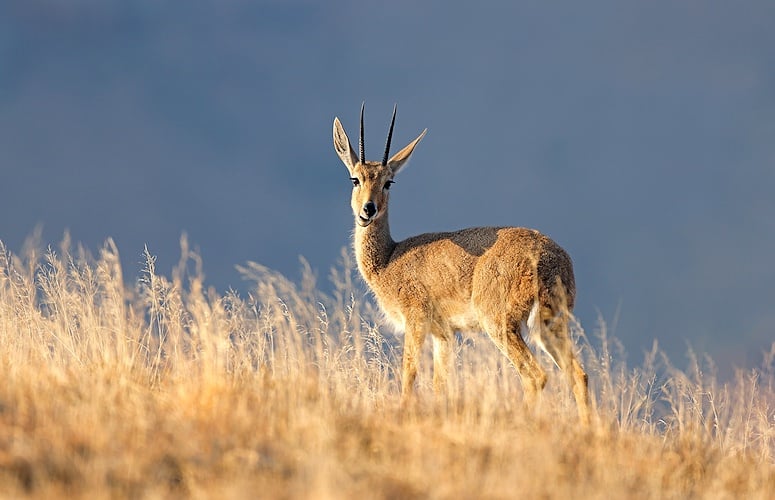- Home
- >
- African Travel
- >
- South Africa
- >
- National Parks
- >
- Kruger National Park
- >
- Mammals
- >
- Grey Rhebok
Description
Grey rhebok have pale gray fur with white underparts and facial markings. Long, slender ears and a dark, bulbous nose aid identification. Only males carry straight, medium-length horns. This medium-sized antelope is adapted to cool, open grasslands and slopes, where small herds keep watchful lookout and move with a distinctive rocking gait.

This species is native to South Africa, Lesotho, and Eswatini. It favors high-lying grasslands such as the uKhahlamba-Drakensberg Park and the escarpment’s plateau edges, typically above 1,000 m. In the Western and Eastern Cape, rhebok also occur close to sea level. Sightings in Kruger National Park are possible but uncommon and localized.

Status
Grey Rhebok are regionally assessed as Near Threatened due to declines recorded across multiple protected areas. While many high-altitude habitats are remote, pressures include habitat change and persecution outside reserves. Notable strongholds remain in parts of the Maloti-Drakensberg and select Cape reserves.

Habitat
Rhebok prefer open grassland and scrub on slopes and high plateaus. Seasonal movement is common: during the rainy season (September–March) they use higher pastures; in the dry winter (April–August) they shift to lower slopes as forage quality declines. They are largely water-independent, obtaining moisture from browse and grasses.

Social Organization
Herds typically include five to ten animals led by one adult male with females and young. Rhebok are territorial; females and offspring usually remain within a male’s territory and mate exclusively with him. Home ranges vary seasonally from about 25 to 100 ha (0.25–1 square kilometer). Bachelor groups are uncommon; young males disperse when able to secure territory.
Finest Safari Areas in Africa for Encountering Grey Rhebok
We recommend the following national parks and private reserves for the best chances of spotting Grey Rhebok on safari game drives and bush walks.

Social Behavior
Open habitats make vigilance essential. Rhebok detect stationary objects at distance and give grunts when alarmed. Males patrol and scent-mark with feces and urine, using upright postures to advertise territory. Intruding males are chased off and may engage in horn clashes typical of antelope contests.

Reproduction
Breeding is seasonal from January to April, timing births for peak forage in November–January. Courtship includes mutual licking and a foreleg-lifting display before mating. Females carry calves for about seven months; twins are rare but recorded. Females reach sexual maturity around four years; males breed successfully once they can defend territory.

Anti-Predator Behavior
Primary predators include caracal, black-backed jackal, and large eagles. When threatened, rhebok snort, stamp, and adopt tall, stiff postures before fleeing; typical flight distance is 150–200 m. Males may confront threats briefly to protect the herd, but speed and distance are the main defenses.












